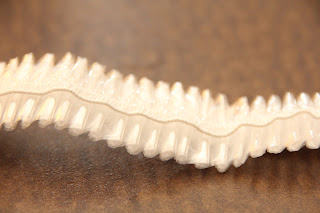Needle tatting gives the same look as traditional shuttle
tatting but is a lot easier to learn (well for myself, anyway!). Any pattern you can make with a shuttle can
be made using the needle method also. So why not give it a try and Wee Care™ is
the perfect place to practice and perfect your technique, whether it be
traditional shuttle or needle tatting.
SAGANews Volume 36
Issue 3 has a project where needle tatting is used on the edge of Wee Care™
gowns and so I thought I would post the basic method on the blog for those
interested in learning or needing a refresher course.
Needle tatting uses a long thin needle with an eye and any
thread, but perle cotton and crochet threads are generally used. The thicker
the thread, the thicker the needle needs to be and the larger the finished
tatting will be. The motion of making a stitch (which consists of two loops) is
one that soon becomes a rhythm as you
work the thread and needle to the front
and then to the back to form each stitch.
Tatting Needle and thread
Thread the needle, leaving at least a 3 inch tail.
The threaded needle is held in the right hand and the strand
coming from the ball of thread is wrapped around the left thumb in a clockwise
direction. The first loop is made by picking up the thread next to the thumb.
This thread will be to the front of the strand coming off the ball. Slide loop
onto the needle.
Thread clockwise, loop picked up from the front
(The thread coming from my left hand is in front of the thread coming from the needle in my right hand)
First loop on needle-thread on top
The next loop is made by wrapping the thread around the
thumb counterclockwise and picking the loop up from behind. The thread from the
ball will be behind.
Thread counterclockwise and loop picked up from behind
(Yes, there is a difference from the other photo-the thread behind my left forefinger is underneath the thread coming from the needle in my right hand)
Second loop on needle-thread is underneath
You will end up with two stitches that should look like this:
You just continue to make the stitches until you have a piece the length you want or need to do something else, like add a picot!
To add picots, pull the first loop of a stitch up, but
stop, leaving a space (depending on size of picot). Make the second loop of the stitch
and pull both up to the previous stitches. Picot formed.
Forming a picot
To form a circle, using the thumb and fore finger of the left
hand and holding the needle with the right hand, slide the stitches to the eye-end of
the needle and off onto the thread.
Pull until end loop is about 2 inches long.
Take needle through this loop and continue to pull to close ring.
Continue pulling until loop is closed.
Closed loop
Thread from the ball is on the left handside
To continue tatting, hold the ring and needle in your right
hand with your thumb and forefinger, making sure that that the thread from the
ball is to the left (this insures the ring will remain with the right side
facing). Pick up the thread from the ball and wrap clockwise around your left
thumb and begin making stitches as before, being sure to pull the first loop
up as close to the end of the ring in your right hand as possible.
You can add tatted chain between your rings or make a line
of rings until you have the length you require. The length of tatting can then
be hand stitched to an item. Or you can tatt the trim directly onto an edge (as
in SAGANews Volume 36 Issue 3). That
edge can be a sleeve, hem, blanket or hankie.
There are many books and items on the Internet about needle
tatting. Supplies are available from various sources and tatting thread is readily available as is perle cotton. So I
hope you will give it try as there are many uses for even the most simple of
pieces, as can be seen on the Wee Care™ in SAGANews
Volume 36 Issue 3.










































